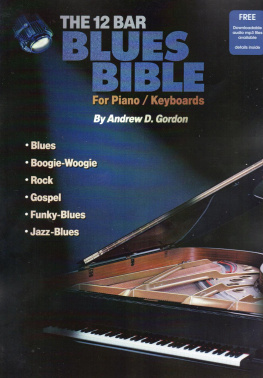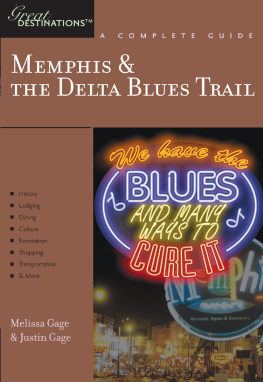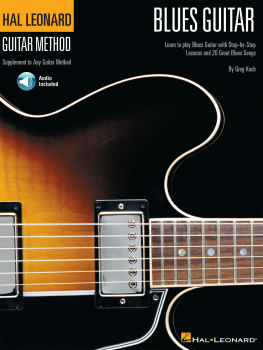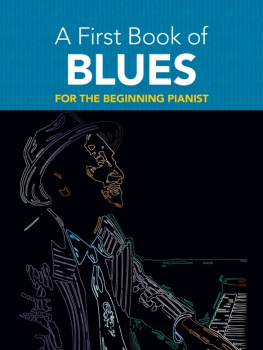FOREWORD
In the late 1940s and early 1950s, the migration of African Americans out of the Mississippi Delta brought any number of talented and ambitious blues musicians to Memphis, where jobs were more plentiful, and the possibility of a better life was a realistic goal. In this fertile climate, for the first time their dreams of making it seemed more than just pipe dreams.
It was to help some of those aspiring musicians that my father, Sam Phillips, first opened his tiny recording studio at 706 Union Avenue, the Memphis Recording Service, in January of 1950, with the avowed purpose of making records with some of those great black artists, as he said, who just had no other place to go. He did this, as he often stated, at the risk of a good radio job, at the risk of his health, and at the risk of his young familys futuregiven the racially charged atmosphere of the time. He did it because of his belief in the music, in the musicians, and in the possibilities that Memphis (and America) had to offer. I always felt that the foundations for the musical contribution that Memphis would make to our world were laid with that original revolution of hopehope in the sense that frustrated, creative, poor people had a place to go, be heard, be themselves musically no matter what that self might be. My fathers mission was to give voice to those who had no voice.
Sam Phillips is probably best known for his discovery of Elvis Presley, Carl Perkins, Johnny Cash, and Jerry Lee Lewis, but he was no less proudand thats an understatementof his involvement with great blues musicians like B. B. King, Howlin Wolf, Rufus Thomas, Little Milton, and Ike Turner, all at the earliest formative stages of their careers. I can only imagine the first time Sam listened and talked with a young, unknown B. B. King or Howlin Wolf, no more than local radio personalities at the time, and convinced them that he wanted to record the music that meant the most to them. I knew the sound I had heard in the cotton fields growing up, Phillips said later in life, and I also knew that had I not tried to captured it, I would have been the biggest damn coward that God ever put on this earth. There was nothing that told the truth, Phillips said, more than gutbucket blues, and even if the white world may not have known it at the time, every one of those artists had something special that was almost bursting to get out. It was the beginning of Memphiss musical self-expression, what my father always prized as self-expression in the extreme. It was the beginning of the Memphis Sound, the Memphis music story. Which at its core is the story of peopleblack people and white peopleworking together.
That legacy of talented people coming together from diverse backgrounds is still the Memphis music story. Every day in studios across Memphis and in the clubs on Beale Street, songs are being written and recorded, records released, and music is being heard by the millions of tourists who come here to experience a little taste of this thing called the blues. But its more than just blues music; it is the culture, the traditions, and the way of life here in Memphis. Its a feeling. We who live here and love it cant define just what it is, but if you let go and become a part of it, you can feel it.
Enjoy this walk through the Delta and Memphis and feel the power of the music that changed the world.
Knox Phillips
ACKNOWLEDGMENTS
A Google search turns up 54 million Web sites with reference to blues music. Its mind-boggling when you think that just over 40 years ago, blacks and whites couldnt legally congregate in the same clubs. Things have changed. We now have the clarity of hindsight and context. When I initially thought about putting this book together, I somehow thought it would be easy. You see, I suffer from the optimism and exuberance of one who is, in Minnie Pearls words, just so proud to be here. I have the enviable job of packaging information and explaining things to people who have little or no knowledge of them. In my work as a filmmaker, I have created documentaries and museum exhibits on subjects as diverse as the Memphis cotton market, Gulf coast lighthouses, Renaissance art, the Mississippi River, cigars, Alzheimers disease, historical cemeteries, urban parks, the Mississippi Delta, 1960s garage bands, and the art of the snowcone. I am fortunate to possess the curiosity of a librarian, the ability to look through thousands of photographs without going bonkers, and the moxie to believe that I can do it all with a flair that will resonate with my audience. I have listened to, read about, followed, debated, and discussed Memphis blues for over 35 years, but the single item that might come closest to qualifying me for this task is this: in my hometown of Rolling Fork, Mississippi, there was a juke joint called the Gold Coast. This club was originally a shotgun shack not unlike the rest of the houses on Blue Front, the street facing the Illinois Central railroad tracks, and home to a large population of African Americans who worked on the plantations, in the cotton gins and warehouses, and as domestics in the homes of the local whites. As a small child in the mid-1950s, I would sneak away from my backyard and walk the hundred yards or so to the back of the Gold Coast and, leaning against the building, feel the deep thunder of the bass and the driving of the kick drum course through my body. This experience, along with the music we heard in the cafs and shoe repair shops, sent me on a lifelong journey, not searching for the blues, but approaching the world with the blues in my pocket. I thank those nameless musicians, those people who dropped nickels in the jukeboxes, and those who lived the Delta life. My most sincere thanks and appreciation is offered to you.
Projects such as this could never be completed if it were not for the generosity of the conservators, writers, musicians, and photographers who populate the world of Memphis music. Help, clarification, and other greatly needed assistance have come from many quarters, and I have had the great pleasure of spending hours with some of the giants of Memphis music. The public archives of the Memphis Room at the Benjamin Hooks Public Library in Memphis and Special Collections of the University of Memphis Library are essential to the research and access to images that make a project such as this possible. I also want to thank the many scholars who have unearthed the truth, debunked the legends, and scoured the sidewalks of Memphis and the dusty backroads of the Delta in search of the blues. We are all in their debt.
Sid Selvidge has been so open, available, and accommodating during this process that I owe him a tremendous debt of gratitude. He has been at the forefront of Memphis music for over four decades, participating in some of the most significant events in our history. Today he is the producer and executive director of the internationally syndicated Beale Street Caravan and continues to record and perform. Dr. Doug Cupples, one of the worlds foremost Civil War scholars, was part of the rediscovery of the blues in the late 1960s. His insight and historical perspective have been essential to my understanding of this vast and rich subject. Judy Peiser is the co-founder of the Memphis-based Center for Southern Folklore. She has been an indefatigable chronicler and champion of the music and culture of Memphis and the South. The centers groundbreaking work in oral histories, films, photography, art, and music set the mark and paved the way for much of todays formalized study of the South. Steve Roberts is a gifted working photographer, specializing in music, whose goodness as a person is reflected back in the faces of his subjects. He recognizes that great photographs come from within. I spent a very enjoyable afternoon in the office of University of Memphis ethnomusicologist Dr. David Evans. He shared photographs and told stories of a time when very few people had an appreciation of the blues. His research, playing, and writing about the blues have added greatly to our knowledge and understanding of this music and culture. What can I say about Tater Red? He is simply the personification of the blues. Hailing from Ruleville, Mississippi, he has made the world richer by hosting the longest-running blues show on Memphis radio, creating unique works of Delta art, and manning the counter at the most important stop on Beale Street. If you dont know Tater Red, youre in for a treat. Executive director of the Blues Foundation Jay Seileman is a tireless and inventive advocate for the blues, a friend to blues lovers everywhere, and a good friend to me. David Less is a Memphis-born blues scholar who has led the Blues Foundation, has written for national magazines, and is the founder of Memphis International Records. His guidance has been both welcomed and essential. Howard Stovall, a longtime friend and colleague, was born on the plantation where Muddy Waters was first discovered and recorded. After having led the Blues Foundation for eight years, he now is the managing partner in Resource Entertainment Group, one the Souths premier talent agencies. And then theres Don Nix: bluesman, songwriter, photographer, author, and rememberer of everything. The Memphis music scene would look very different indeed if Don Nix had not been around. His generous spirit and deep knowledge make him the ultimate Memphis treasure. Knox Phillips is a member of Memphiss first family of music. Throughout his long career, he has been a producer, publisher, label owner, and every other job one can hold in the music business. But it has been his commitment and dedication to the Memphis music and film communities that have defined him as the generous, unique, and talented person he is today. It is my pleasure to be his friend.










